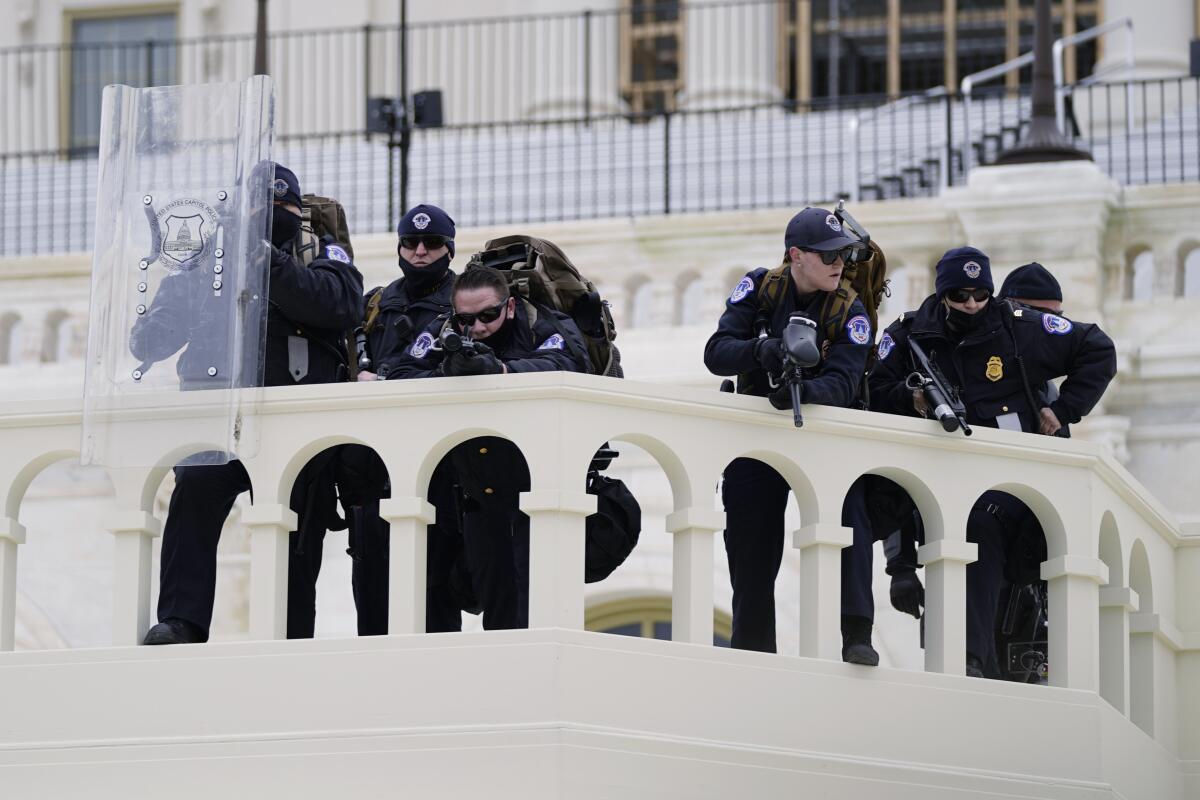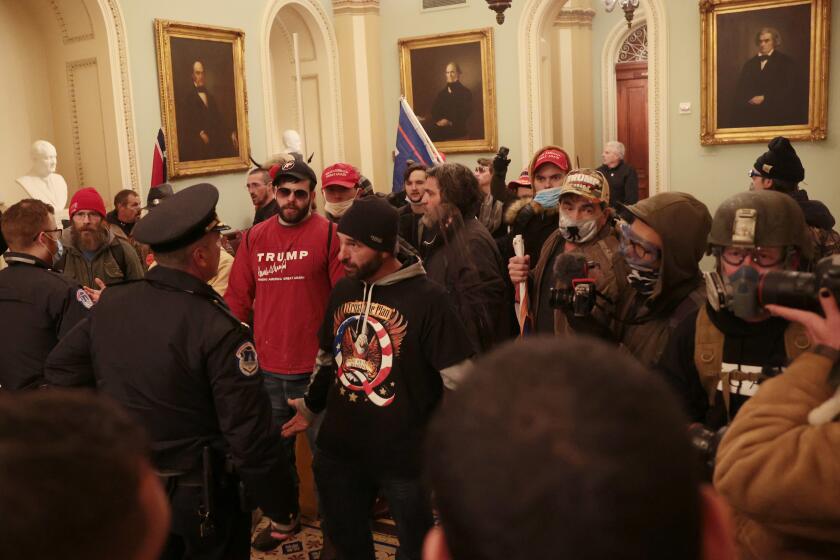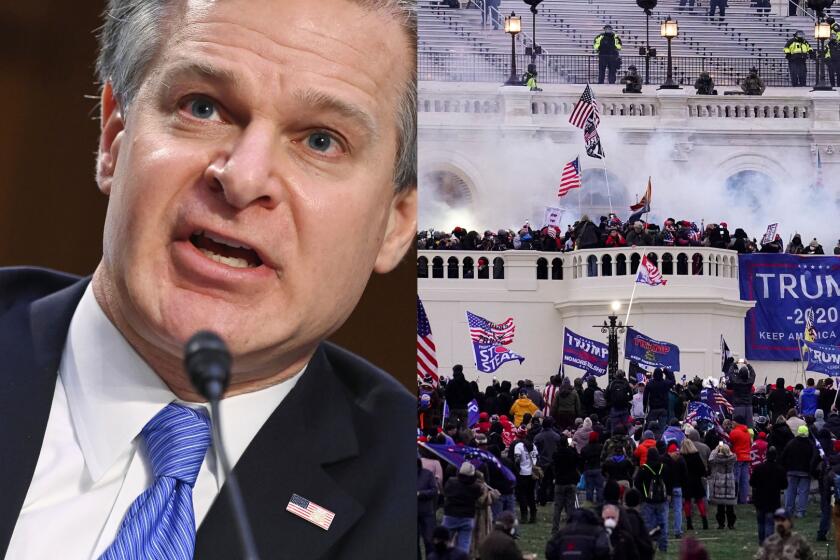Scathing report details how Capitol Police were caught unprepared for Jan. 6 riot

- Share via
WASHINGTON — A blistering internal report by the U.S. Capitol Police describes a multitude of missteps that left the force unprepared for the Jan. 6 insurrection: riot shields that shattered upon impact, expired weapons that couldn’t be used, inadequate training and an intelligence division that had few set standards.
The watchdog report, released internally last month and obtained by the Associated Press ahead of a congressional hearing Thursday, adds to what is already known about broader security and intelligence failures that Congress has been investigating since hundreds of supporters of former President Trump laid siege to the Capitol.
In an extensive and detailed timeline of that day, the report describes conversations between officials as they disagreed on whether National Guard forces were necessary to back up the understaffed Capitol Police force. It quotes an Army official as telling then-Capitol Police Chief Steven Sund that “we don’t like the optics of the National Guard standing in a line at the Capitol” after the insurrectionists had already broken in.
Inspector General Michael A. Bolton found that the department’s deficiencies were — and remain — widespread. Equipment was old and stored badly, leaders had failed to act on previous recommendations to improve intelligence, and there was a broad lack of current policies or procedures for the Civil Disturbance Unit, a division that existed to ensure that legislative functions of Congress were not disrupted by civil unrest or protest activity.
That was exactly what happened on Jan. 6 as Trump’s supporters sought to overturn the election in his favor as Congress counted the electoral college votes.
The report comes as the Capitol Police’s morale plunges and as the force edges closer to crisis, with many officers working extra shifts and forced overtime to protect the Capitol after the riot. Acting Chief Yogananda Pittman received a vote of no confidence from the union in February, reflecting widespread distrust among the rank and file.
Two brothers from the L.A. area are accused of entering U.S. Capitol through a window during the Jan. 6 riot
The entire force is also grieving the deaths of two of their own — Officer Brian Sicknick, who collapsed and died after engaging with protesters Jan. 6, and Officer William “Billy” Evans, who was killed April 2 when he was hit by a car that rammed into a barricade outside the Senate. Evans lay in honor in the Capitol Rotunda on Tuesday.
The Capitol Police have so far refused to publicly release the report — marked throughout as “law enforcement sensitive” — despite congressional pressure to do so. House Administration Committee Chairwoman Zoe Lofgren (D-San Jose) issued a statement in March that she had been briefed on the report, along with another internal document, and that it contained “detailed and disturbing findings and important recommendations.“
Bolton is expected to testify before her panel Thursday.
The report focuses heavily on the failure of equipment and training Jan. 6 as Capitol Police were quickly overwhelmed by around 800 Trump supporters who pushed past them, beat them and broke windows and doors to get into the building. It also looks at missed intelligence as the insurrectionists planned the attack openly online, and as various agencies sent warnings that were disseminated incorrectly.
FBI Director Christopher Wray defends the bureau’s actions days before a pro-Trump mob stormed the Capitol in a deadly insurrection.
Bolton found that, in many cases, department equipment had expired but was not replaced, with some of it more than 20 years old. Riot shields that shattered on impact as the officers fended off the violent mob had been improperly stored, Bolton found. Some weapons that could have fired tear gas were so old that officers didn’t feel comfortable using them.
In other cases, weapons weren’t used because of “orders from leadership,” the report says. Those weapons — called “less lethal” because they are designed to disperse, not kill — could have allowed the police to better push back the rioters as they moved toward the building, according to the report.
In terms of the Civil Disturbance Unit, the report said there was a total lack of policy and procedure, and many officers didn’t want to be a part of it. There were not enough guidelines for when to activate the unit, how to issue gear or what tactics to use. Some of the policies hadn’t been updated in more than a decade, and there was no firm roster of who was even in the division.
The unit was at a “decreased level of readiness and preparedness” because there were no standards for equipment, the report said.
Breaking News
Get breaking news, investigations, analysis and more signature journalism from the Los Angeles Times in your inbox.
You may occasionally receive promotional content from the Los Angeles Times.
Bolton also laid out many of the missed intelligence signals — including a report prepared by the Department of Homeland Security in December that forwarded messages posted on forums supportive of Trump that appeared to be planning for Jan. 6. One part of that document included a map of Capitol tunnels that someone had posted. “Take note,” the message said.
The report looks at a missed memo from the FBI about online activists predicting a “war” on Jan. 6 — Sund told Senate investigators last month that he never saw it. Bolton also details the force’s own internal reports, which he said were inconsistent. One Capitol Police report predicted that the protesters could become violent, but Sund testified before the Senate in February that internal assessments had said violence was “improbable.”
On intelligence, Bolton said, there was a lack of adequate training and guidance for dissemination within the department. There were no policies or procedures for open-source data-gathering — such as from the online Trump forums — and analysts “may not be aware of the proper methods of conducting open-source intelligence work.”
A timeline attached to the report sheds new light on conversations in which Sund begged for National Guard support. Sund and others, including the head of the D.C. National Guard, have testified that Pentagon officials were concerned about the optics of sending help.
Social media was key to the Capitol riot. Now courts are struggling with whether suspects should be banned from using the internet.
The document gives the clearest proof yet of that concern, quoting Army Staff Secretary Walter Piatt telling Sund and others on a call that “we don’t like the optics” of the National Guard at the Capitol and he would recommend not sending them. That was at 2:26 p.m., as rioters had already broken through windows and as Sund desperately asked for the help.
The Pentagon eventually approved the Guard’s presence, and Guard members arrived after 5 p.m.
More to Read
Sign up for Essential California
The most important California stories and recommendations in your inbox every morning.
You may occasionally receive promotional content from the Los Angeles Times.












